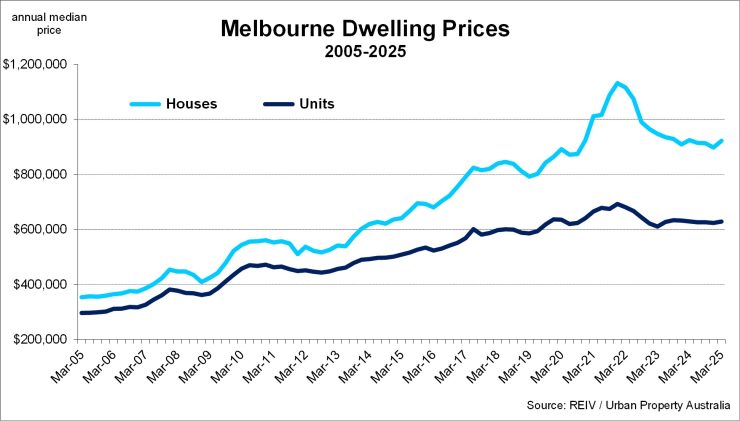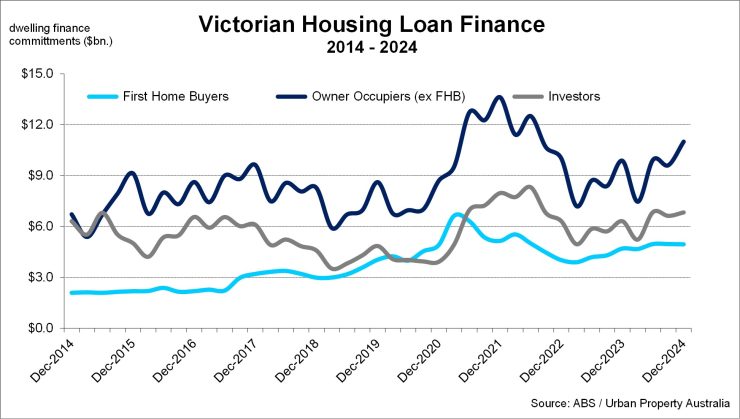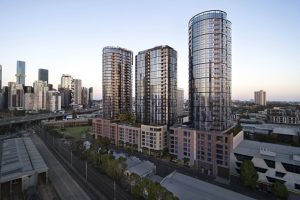Q1 2025 – Melbourne Residential Market
April 26th 2025 | , Urban Property Australia
- For the first time in 12 months, Melbourne’s median house price increased over a quarter but remains 0.3% lower than prices recorded 12 months ago;
- While rents for houses in metropolitan Melbourne increased over the year, growth rates have moderated, as affordability pressures have impacted the capacity of renters to absorb the significant growth observed in recent years;
- Despite population growth close to all-time highs, the number of dwellings currently under construction in Victoria is 20% below its peak with annual completions at their lowest level in 10 years.
Residential Market Summary
For the first time in 12 months, Melbourne’s median house price increased over a quarter having declined in 11 quarters over the past three years but remains 0.3% lower than prices recorded 12 months ago. Despite population growth close to all-time highs, the number of dwellings currently under construction in Victoria is 20% below its peak with annual completions at their lowest level in 10 years. The vacancy rate for Melbourne residential property increased to 2.5% compared to its rate of 2.1% a year earlier but remains below the 10-year average of 3.0%.
Prices
According to the REIV, for the first time in 12 months, Melbourne’s median house price increased over a quarter having declined in 11 quarters over the past three years. As at March 2025, Melbourne’s median house price was $922,500 having increased by 2.7% over the quarter but remains 0.3% lower than prices recorded 12 months ago according to the REIV. Similarly, Melbourne median unit prices increased over the first quarter of 2025, rising to $629,000, up 0.9% over the quarter. Like the detached housing market, as at March 2025, the Melbourne median unit price remains lower than levels recorded 12 months ago with current levels 0.1% lower than those recorded in March 2024. Currently, median prices of both Melbourne houses and units remain significantly below their peak levels with median house prices 18% lower and median unit prices 9% below their peak. Outside of Melbourne, the median Victorian Regional house price increased over the March 2025 quarter, increasing to $598,000, the highest quarterly increase since 2022. The median Victorian Regional unit price also increased over the quarter, rising to $421,500, but remains 3% off their peak recorded in 2022.

Supply
According to the ABS, there are currently 59,500 dwellings under construction across Victoria, 11% lower than the activity recorded 12 months ago, with both high-density apartment development and the detached housing market development levels more than 10% lower than the preceding year. Despite population growth close to all-time highs, the number of dwellings currently under construction in Victoria is 20% below its peak. The level of new dwellings completed in Victoria in 2024, was the lowest level in 10 years. Looking forward, supply levels are projected to continue to remain subdued with commencements continuing to ease having decreased by 1% over the year. The decline in the pipeline of housing stock is further evidenced by decreasing level of approved dwellings in Victoria with current levels 13% lower than the 10-year average. In order to encourage supply, the Victorian state government has recently announced two policies that aim to give developers an incentive to build. Firstly, stamp duty was reduced from October 2024 and be in place for 12 months and available for off-the-plan units, townhouses and apartments for properties at any price point. Secondly, to encourage more density around railway and tram lines, the government has identified 50 new activity centres where the planning process for multi-storey residential dwellings will be streamlined to fast-track development.
Demand
Victoria’s population is growing at close to record levels, increasing by over 140,000 over the 12 months to September 2024, the highest level of any Australian state. Victoria’s population growth was driven by overseas migrants with the state also recording net growth of interstate movement. Total quarterly Victorian housing finance commitments continue to gather momentum having steadily increased since 2023 and now sit 16% above the 10-year average as at December 2024 with $83.1 billion financed. Dwelling finance commitments have increased across all categories over the past 12 months. Non-first home buyer owner occupier finance levels have increased by 11% compared to the preceding year; with first home buyers also active with their levels 5% higher than last year. Investors now account for 30% of total housing finance commitments in Victoria, slightly below the average share of 31% over the past 10 years. Looking ahead, with strong rental growth and a shortage of housing, Urban Property Australia expects that investors will grow their share of housing loans as affordability challenges restrict owner occupiers despite increases in land taxes.

Vacancy
According to the REIV, as at March 2025, the vacancy rate for Melbourne residential property increased to 2.5% compared to its rate of 2.1% a year earlier but remains below the 10-year average of 3.0%. All precincts’ current vacancy rates now sit below their respective 10-year averages; with the Middle precinct decreasing marginally over the year in contrast to the Inner and Outer precincts which recorded increases in vacancy rates over the year. The vacancy rate of the Inner (4-10km) region recorded the tightest rate at 1.3%, down from 1.5% 12 months earlier. The Inner Melbourne region holds the highest vacancy rate at 2.7% while the vacancy rate of the Outer region sits at 1.7%. Looking ahead, Urban Property Australia projects that the vacancy rate for the metropolitan Melbourne area will remain low with falling supply levels coupled with population growth of Melbourne currently at close to record high levels.
Rents
Reflecting the low vacancy environment, according to the REIV, metropolitan residential rents across the precincts increased over the past year. Over the year to March 2025, the weekly median rent for houses in metropolitan Melbourne increased to $580 per week, up from $570 per week a year earlier. Across Melbourne, rents for houses located in the Inner region increased the most, increasing by 2.9%, with rents in the Outer region increasing by 1.9% and the rents in the Middle precinct remaining steady. Melbourne units recorded stronger rental growth with annual rises of average rents increasing by 4.5% over the year with all precincts recording rental growth for units. Looking forward, Urban Property expects that residential rents will continue to rise, however the growth rates will moderate, as witnessed over the past year as affordability pressures begin to impact capacity of renters to absorb the significant growth observed in recent years.
Regional
The median Victorian Regional house price increased over the March 2025 quarter, rising to $598,000 – however remains below its peak recorded in 2022. The median Victorian Regional unit price also rose over the quarter, increasing to $421,500, and similarly remains below its peak level recorded in 2022. In contrast to the performance of median prices in Regional Victoria, rental levels in the Regional markets have remained resilient with the average weekly rental levels for both houses and units increasing at all-time highs as at March 2025. The vacancy rate for Regional Victoria remains very tight at 2.1%, below the metropolitan average of 2.5%.
Copyright © 2025 by Urban Property Australia All rights reserved. No part of this publication may be reproduced in any form, by microfilm, xerography, electronically or otherwise, or incorporated into any information retrieval system, without the written permission of the copyright owner.



